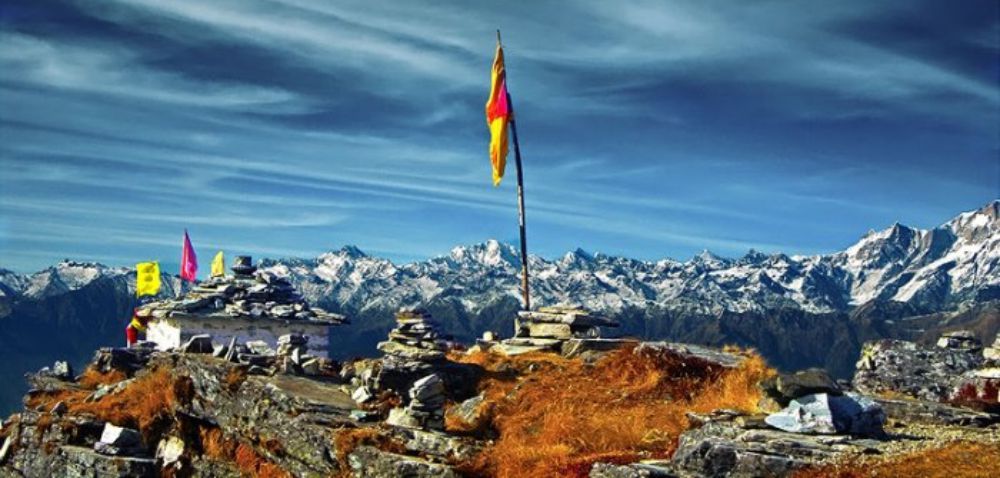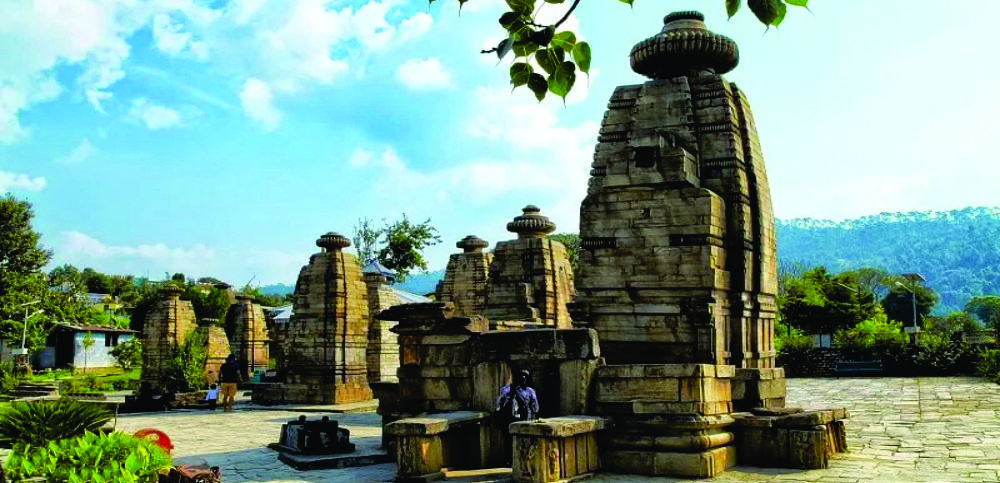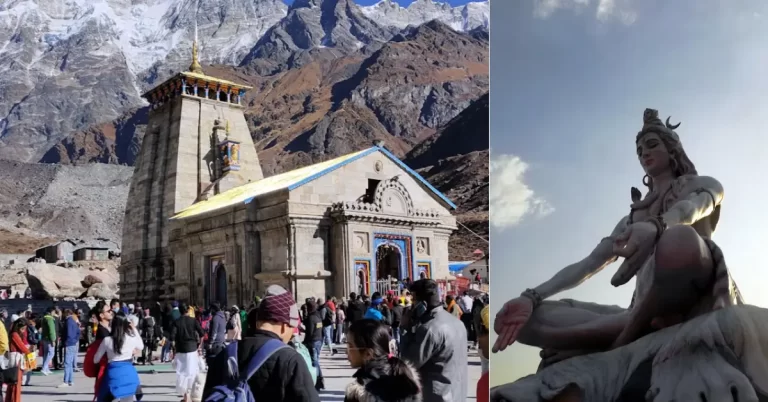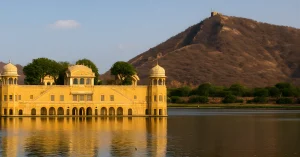Why is Uttarakhand called Devbhoomi? It’s a question I asked myself the first time I visited this magical state. As our car climbed through the winding Himalayan roads and the mist slowly gave way to towering temples and peaceful villages, I started to understand the answer without even needing to hear it.
Uttarakhand isn’t just another travel destination, it’s a place where spirituality flows as freely as the rivers. From ancient temples nestled in the mountains to sacred rituals passed down for generations, every part of this land feels blessed. And that’s exactly why it’s known as Devbhoomi, the Land of the Gods.
Why is Uttarakhand Called Dev Bhoomi? Top Reasons Behind the Name

- The first and most crucial reason is that Uttarakhand was named Dev Bhoomi in the Vedas or Puranas and is separated into two halves, Kedar Khand and Manas Khand (Currently, which are the Garhwal and Kumaon regions).
- People used to come here in the past and still do now to concentrate on God, seek salvation, discover the path to God, and become a part of God. People can practice meditation in Uttarakhand without being disturbed or distracted. According to legend, the Pandavas enjoyed their stay here as well.
- India’s longest river The Ganga River originates from Gangotri Glacier in Uttarkashi District of Uttarakhand, while the Yamuna River, which is the longest tributary in India, originates from Yamnotri Glacier.
- The largest mass Hindu pilgrimage in the world, Kumbh Mela, which is observed four times during 12 years. These four locations are Prayag, Nasik, Ujjain, and Haridwar (which is in Uttarakhand).
These including many more reasons contribute as to why Uttarakhand is also called as Dev Bhoomi.
History of Uttarakhand

The Indian state of Uttarakhand, originally known as Uttaranchal, is situated in the northwest of the nation. It shares borders with the Tibetan Autonomous Region of China to the northeast, the Indian state of Himachal Pradesh to the northwest, Nepal to the southeast, and the Indian states of Uttar Pradesh to the south and southwest. The city of Dehra Dun in the northwest serves as its capital.
The Garwhal is located in the western part of the state of Uttaranchal, and Kumaon is located in the eastern part. There have been several dynasties that have ruled over this area, including the Kutuyi, the Chand Rajas, and the Guptas. The first invasion by the Gurkhas from Nepal against the Kumaon kingdom occurred in the 18th century.
Garwhal then assisted the British in advancing and capturing a sizable portion of the area through the Sigauli Treaty in 1817. Following independence, this area was amalgamated with Uttar Pradesh. Following an outspoken separatist campaign, the current state of Uttaranchal was created in 2000.
Uttarakhand Religious Places You Shouldn’t Miss
One thing I’ve learned from traveling through Uttarakhand is this: you don’t need to go looking for spirituality here. It’s already all around you.
Whether it’s a tiny shrine under a tree or a centuries-old temple perched on a cliff, every corner of this state has something sacred about it. If you’re planning a visit and want to tap into the spiritual side of the mountains, here are some of the most meaningful and soul-stirring places to explore:
1. Kedarnath Temple – More Than Just a Pilgrimage
Visiting Kedarnath is an experience that stays with you. The trek is tough, the altitude is high, and yet, once you see the temple standing there, majestic, quiet, powerful—it all makes sense. It’s not just a place for religious people, it’s a place for anyone looking for peace and perspective.
Tip: Don’t rush. Let the journey be as important as the destination.
2. Badrinath Temple – Where Divinity Meets Beauty
Badrinath feels like it was taken straight out of a dream. The bright colours of the temple set against a dramatic Himalayan backdrop make it one of the most photogenic (and sacred) places I’ve ever been to. You can almost feel the presence of something ancient and eternal here.
Best time: Late spring to early autumn, when the temple is open and the roads are clear.
3. Gangotri & Yamunotri – Source of the Sacred
There’s something deeply emotional about standing at the spot where the Ganga and Yamuna rivers begin their journey. The air feels pure. The surroundings are raw. And people come here with the kind of faith that gives you goosebumps—even if you’re not religious yourself.
My moment: Watching an elderly couple cry softly while offering prayers—something about that moment felt incredibly human and divine.
4. Haridwar – Where the Ganga Comes Alive
The first time I witnessed the Ganga Aarti at Har Ki Pauri, I was speechless. Hundreds of flickering diyas floating on the river, the sound of bells, chants echoing in the air—it felt like a movie scene, only very real. It’s spiritual, emotional, and oddly grounding.
Go early: It gets crowded, but the energy is worth it.
5. Rishikesh – Not Just for Yogis
Rishikesh is one of those places where everything just feels a bit more aligned. Sure, there are yoga classes and cafes with organic food, but it also has this quiet spiritual pull, especially when you’re sitting on the ghats during sunset, listening to the river flow.
Don’t miss: A walk across the Laxman Jhula at dusk. Pure magic.
6. Jageshwar Dham – A Hidden Gem in the Forest
Tucked away in a dense cedar forest, Jageshwar is a cluster of stone temples that most people have never even heard of. I stumbled upon it on a road trip through Almora, and it instantly became one of my favorite spots. Peaceful, quiet, mysterious.
For you: if you like offbeat, soulful places that aren’t flooded with tourists.
7. Hemkund Sahib – High on Faith
At 4,300 meters above sea level, this place literally takes your breath away. But it also fills you with a kind of spiritual calm I can’t really explain. It’s a sacred Sikh site with a serene glacial lake and snow-covered peaks all around. Getting there isn’t easy, but that’s part of what makes it unforgettable.
Plan well: You’ll need to trek, so give yourself enough time to acclimatize.
8. Neelkanth Mahadev Temple – A Quick Escape into the Sacred
Just outside Rishikesh, this temple is believed to be where Lord Shiva drank the poison during the Samudra Manthan. Whether or not you believe the myth, the energy here feels powerful. Plus, the drive through the jungle is a beautiful bonus.
Pro tip: Combine it with a half-day trip from Rishikesh.
A Little Advice from My Journey
If you’re planning a spiritual getaway—or just want to soak in the calm that these places offer—don’t try to see it all at once. Pick a few places, take your time, and allow yourself to really feel each moment. That’s when Uttarakhand begins to reveal its magic.
Uttarakhand: Places to visit that are thrilling

Any type of traveler from around the world can find fulfillment in Uttarakhand thanks to its thrilling adventures, pristine greenery, blissful landscapes, surreal vistas of enormous Himalayan Peaks that appear from every angle, temples steeped in tradition, history, and mysticism, and mesmerizing floral and animal wealth.
It is one of the top vacation spots since it provides everything a traveler might want on a holiday. Uttarakhand is a wonder of beauty and delight forever, offering everything from spiritual grace and picturesque panoramas to exhilarating fun and wildlife experiences.
Here are some of the best places to visit in Uttarakhand for an amazing vacation:
- Mussoorie
- Nainital
- Almora
- Ghangaria
- Chaukori
- Kausani
- Pithoragarh
- Lohaghat
- Khati Village
- Mana Village
- Jim Corbett National Park
- Chakrata
- Dwarahat
Why Uttarakhand is the best place to visit for a vacation with your family

When we imagine Uttarakhand, don’t we feel as though a mist has kissed our faces and we are taking in the cool air in the midst of nature? One of the most picturesque states in the nation, Uttarakhand is home to some of the friendliest people, delectable pahadi food, and unmatched natural beauty. Here are some of the top reasons for visiting Uttarakhand in case you are still unsure of why you should do so.
- You can enjoy an amazing valley of flowers.
- Go rafting with your friends and family for some adventure.
- The perfect getaway from your daily life is some wildlife, so why not the Jim Corbett National Park.
- Adventurous sports like bunjee jumping.
- And of course, the serene beauty of the Himalayas.
- Don’t forget the holy cities of Uttarakhand to enjoy the peaceful pujas.
- You can also enjoy amazing and beautiful monasteries of the state.
- You might also try to figure out the mystery of Roopkund’s scary and interesting skeleton lake.
Conclusion
If you are a traveller and love the beauty of nature, Uttarakhand is a beautiful place to explore. From religious places to festivals to foods to serene beauty, it’s all in Uttarakhand. For me, it’s the place where dreams come true. If it’s your honeymoon, and you want to enjoy some alone and romantic time with your partner, you can enjoy hill stations like Mussoorie and Nainital.
The state of beautiful Uttarakhand also known as Dev Bhoomi is the holy place where the Lord resides and is one of the most religious places in India.
We hope you enjoy your next trip to the beautiful cities of Devbhoomi.
FAQs
Uttarakhand is called Devbhoomi, which means “Land of the Gods”—because of its deep spiritual roots. It’s home to the Char Dham Yatra (Kedarnath, Badrinath, Gangotri, Yamunotri), countless temples, and legends linked to Lord Shiva, Vishnu, the Pandavas, and more. Spirituality isn’t just part of the culture here—it is the culture.
Some of the most sacred sites include Kedarnath, Badrinath, Haridwar, Rishikesh, Gangotri, Yamunotri, Hemkund Sahib, and Jageshwar Dham. Whether you’re a pilgrim or just spiritually curious, each place offers something deeply meaningful.
Not at all! While it’s a major hub for spiritual seekers, Uttarakhand is also perfect for trekking, river rafting, wildlife spotting, yoga retreats, and peaceful getaways in the hills. You can explore places like Auli, Nainital, Jim Corbett, and Valley of Flowers even if you’re not on a religious trip.
The Char Dham Yatra is a sacred pilgrimage circuit to four high-altitude temples—Kedarnath (Shiva), Badrinath (Vishnu), Gangotri (Ganga), and Yamunotri (Yamuna). It’s believed that completing this journey washes away sins and helps you attain moksha (liberation). Every year, thousands of devotees brave the mountains for this powerful experience.
Uttarakhand has a rich blend of history, mythology, and mountain traditions. It was ruled by dynasties like the Katyuris, cherished by sages and saints, and later shaped by colonial and post-independence movements. Its temples, festivals, and local customs still reflect this deep, timeless heritage.







You must be logged in to post a comment.